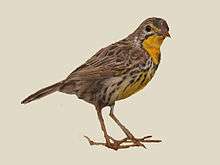Pangani longclaw
| Pangani longclaw | |
|---|---|
 | |
| specimen at Nairobi National Museum | |
| Scientific classification | |
| Kingdom: | Animalia |
| Phylum: | Chordata |
| Class: | Aves |
| Order: | Passeriformes |
| Family: | Motacillidae |
| Genus: | Macronyx |
| Species: | M. aurantiigula |
| Binomial name | |
| Macronyx aurantiigula Reichenow, 1891 | |
The Pangani longclaw (Macronyx aurantiigula) is a species of bird in the Motacillidae family, which includes the pipits and wagtails. It is found in Tanzania, Kenya and Somalia. The bird's natural habitats are dry savanna and subtropical or tropical dry lowland grassland.
Originally described by German ornithologist Anton Reichenow in 1891, the Pangani longclaw is a member of the longclaw genus Macronyx. The genus name is derived from the Ancient Greek words μακρός/makros "long", and ονυξ/onyx "claw" or "talons".[2] The species name is derived from the Latin words aurantium "orange", and gŭla "throat" or "gullet"[3]
The Pangani longclaw measures around 20 cm (8 in) in length.[4] As its species name suggests, it has an yellow-orange throat. This is bordered with a black necklace. The upperparts are mottled various shades of brown, and the belly is yellow. In immature birds, the belly is more buff than yellow and the dark breast band less distinct.[4] The flanks are streaked black and buff. The flight is jerky.[5] The call has been described as a high-pitched siuuweeeee, with a pitch that rises, falls then rises before fading away.[5]
Its more orange throat helps distinguish it from the yellow-throated longclaw and Abyssinian longclaw, however the throats of female and older immature Pangani longclaws can be more yellow.[4][5] The last species is also found further north in the Horn of Africa in Ethiopia.[4]
A predominantly ground-dwelling bird, the Pangani longclaw inhabits grasslands,[4] to an altitude of 1800 m (5500 ft).[5]
References
- ↑ BirdLife International (2012). "Macronyx aurantiigula". IUCN Red List of Threatened Species. Version 2013.2. International Union for Conservation of Nature. Retrieved 26 November 2013.
- ↑ Liddell, Henry George; Scott, Robert (1980) [1871]. A Greek-English Lexicon (abridged ed.). Oxford, United Kingdom: Oxford University Press. pp. 423, 491. ISBN 0-19-910207-4.
- ↑ Simpson DP (1979). Cassell's Latin Dictionary (5th ed.). London: Cassell Ltd. p. 269. ISBN 0-304-52257-0.
- 1 2 3 4 5 Nigel Redman; John Fanshawe; Terry Stevenson (2009). Birds of the Horn of Africa: Ethiopia, Eritrea, Djibouti, Somalia, Socotra. A&C Black. p. 294. ISBN 0-7136-6541-6.
- 1 2 3 4 Terry Stevenson; John Fanshawe (2004). Birds of East Africa. A&C Black. p. 302. ISBN 0-7136-7347-8.
